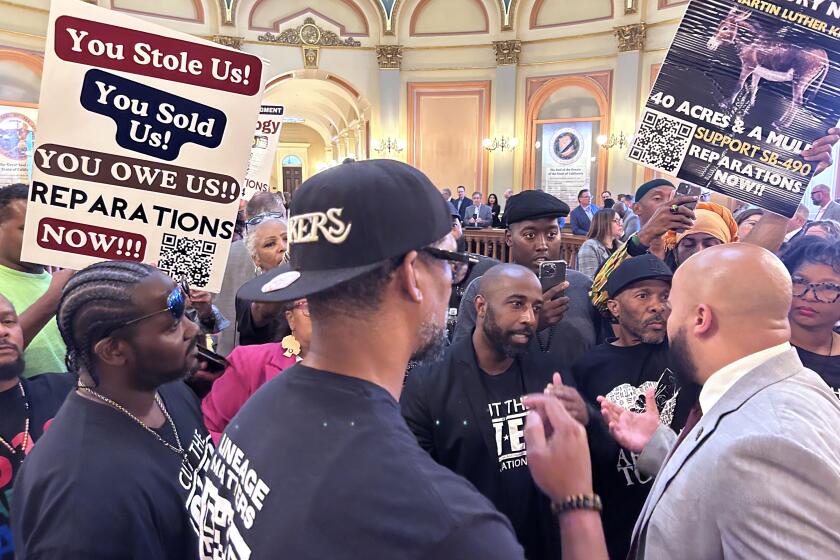Want to Live Longer? Look to the Latino Lifestyle
- Share via
America’s baby-boomer generation is graying--and the programs that today’s elderly depend upon to keep them out of poverty and in relative good health may run out of money just when the baby boomers become eligible to tap them. Medicare, by most estimates, will be broke by 2003. Social Security may go bust around 2009. The first baby boomers turn 65 in 2010. How can they and their generation conceive of a comfortable, secure old age?
Multicultural Los Angeles may offer a model. The largely Anglo baby-boomer generation would do well to look not to their parents, but to Latino senior citizens for hints of how to adjust to and enjoy their twilight years.
This suggestion may come as a surprise. Discussions about Latinos typically focus on their youth, their fertility rates and their children. After all, the median age of Latinos is more than 10 years younger than that of Anglos. But our emphasis on the youthful character of the Latino population obscures a compelling fact: Not only is America graying, the elderly are increasingly Latino.
This trend has remained largely unnoticed because of a widely shared stereotype: Because Latinos are a minority, many assumed that they, like other minorities, have shorter life expectancies. Even many pro-Latino advocacy groups believe that Latino seniors “live fewer total years, have fewer years of retirement and spend more time disabled.” One researcher even contended that elderly Latinos and blacks should be allowed to retire earlier, on the ground that they die younger and thus receive few, if any, Social Security benefits.
But the reality is quite different. An Anglo baby born in Los Angeles County has a life expectancy of 73.9 years (both sexes combined). The Latino baby in the adjacent bassinet has a life expectancy of 78.0 years, nearly four years longer. Put another way, the Anglo baby can expect 8.9 years of senior citizenship beyond age 65, while his Latino counterpart can look forward to 12.9 years. In part due to migration patterns, the number of Anglo elderly in the county has been shrinking for 20 years, yielding a 10-year growth rate of about minus-7%, while the Latino elderly growth rate is about 82%.
Elderly Latinos in the county, moreover, have lower death rates than Anglos for heart disease, cancer, stroke, pneumonia, homicide, suicide and cirrhosis. Elderly Latinos die of such causes at a rate nearly 40% lower than that of Anglos, except for diabetes.
With Medicare facing bankruptcy, the health patterns of Latino seniors merit much closer investigation, because their longer life expectancy is not the result of greater use of hospitals and doctors. Quite the contrary. For example, in 1990, an Anglo senior, on average, generated $13,800 in hospital charges. By contrast, his Latino counterpart was billed $3,600 during her hospital stay.
Latino senior citizens use hospitals less, yet live longer and die less of heart disease, cancer or strokes. This is good news for Medicare. How do they do it?
While more data are necessary to answer this question definitively, most analysts aware of the seeming paradox of longer life expectancies for Latinos point to lifestyle as a determinant. Chief among the “habits of the Latino heart” are the importance of family, the maintenance of a work ethic, the role of religion and the formation of community.
One hotly debated idea to save Social Security from bankruptcy is to raise the retirement age by a few years. For elderly Latinos, working longer is already a way of life. Their labor-force participation rate at age 65 and older far exceeds that of their Anglo counterparts. Furthermore, after contributing so much for so long, Latino seniors are much less likely than Anglos to tap Social Security. While 88% of Anglo seniors receive Social Security payments, only 54% of elderly Latinos do. Yet, working elderly Latinos are bedeviled by the same problem that affects Latino workers of all ages: Although they work more, they are more likely to live in poverty.
It is important to note that the average Latino senior is an immigrant who has been living in the United States for 31 years. He or she arrived in this country when relatively young and has worked far more than the 40 quarters required by Social Security. Unfortunately, many of the jobs once held by today’s Latino seniors were not covered by Social Security. After all, in 1950, 52% of Latino males were either farm workers or unskilled laborers.
But while senior Anglos are much more likely to rely on institutional support, elderly Latinos tend to lean on family to offset the lack of Social Security income. In Los Angeles County, 21% of the Latino seniors receive cash income from their adult children. By contrast, only 2% of elderly Anglos receive financial assistance from their adult children. Of course, Latinos in Los Angeles are more than twice as likely as Anglos to marry and have children. And Latino parents are eager to invest in their children, often at great personal sacrifice. Later in life, their investment appears to pay off in the form of productive and appreciative children. Today’s working-age, U.S.-born Latinos are 80% less likely to live in poverty than their parents.
Berkeley epidemiologist Len Syme has concluded that one’s family and social networks are the best predictors of health status. Nearly a century ago, Emil Durkheim found that persons with active family relations were less likely to commit suicide. While a numerical value has yet to be assigned to it, Latinos’ tendency to form families is doubtless another reason for their strong health profile.
Stanford researcher Marilyn Winkleby has also found that though Anglo adults demonstrate better knowledge of diet and nutrition than Latino adults, when it comes to actual consumption, Latino adults tend to have healthier eating habits. She notes that, overall, Latino meals are richer in vegetables and legumes, and leaner in meats.
A full religious life is another promoter of longer life. Compared with Anglo seniors, Latinos are twice as likely to be a member of an organized church, and their church of choice is Roman Catholic. These seniors are not simply Catholic in name only. Elderly Latinos are more than twice as likely as Anglos to attend a church service at least every two weeks. Religious observance can reduce stress by promoting a sense of belonging and a heightened sense of well-being.
Studies have shown that religious faith can have a positive effect on health, physical, mental and social. A recent Hebrew University study comparing religious kibbutz members with secular kibbutz members discovered that members of the former had far lower death rates for all major causes of death. The researchers were themselves surprised at finding the “embracing protective effect of religious observance.”
The notion of koinonia (community), so much a part of Latino Catholic culture, appears to have many positive payoffs for the lives of elderly Latinos. Religious prescriptions and proscriptions on behavior urging self-discipline, responsibility to others and faith can also protect people from threats to their health.
Working longer, living healthier lives, relying more on family, making less use of Social Security and Medicare--these are not impossible policy decisions: These are personal decisions already made by many Latino senior citizens living in California. Yet, their life expectancy is not correspondingly shortened.
The habits of the Latino heart--family and diet, religion, work and culture--make for a profile that results in healthier and longer life. As America grays and old-age programs become financially strapped, it’s worth pondering the Latino model as a way to avoid a calamitous retirement.
More to Read
Sign up for Essential California
The most important California stories and recommendations in your inbox every morning.
You may occasionally receive promotional content from the Los Angeles Times.










